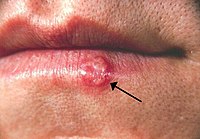
Photo from wikipedia
Objectives To assess the seroprevalence of herpes simplex virus (HSV) types 1 and 2 in patients infected with HIV in Nigeria. Design Cross-sectional design from January to June 2019. Setting… Click to show full abstract
Objectives To assess the seroprevalence of herpes simplex virus (HSV) types 1 and 2 in patients infected with HIV in Nigeria. Design Cross-sectional design from January to June 2019. Setting Federal Teaching Hospital, Ebonyi State, Nigeria. Participants A total of 276 patients with HIV were analysed using ELISA method for the presence of HSV-1 and HSV-2 specific IgG antibodies. Outcomes Fisher’s exact test was used to determine the association between the seroprevalence of HSV and demographic variables (statistically significant=p value ≤0.05). Results Totally, 212 (76.8%) and 155 (56.2%) patients with HIV were seropositive for HSV-1 and HSV-2 IgG antibodies, respectively. The seroprevalence of HSV-1 was significantly higher than the HSV-2 in patients with HIV (p value <0.0001). HSV-1 and HSV-2 seroprevalence were higher in patients aged more than 30 years. The seroprevalence of HSV-1 was significantly higher (p=0.01) in females (82.4%, 131/159) than males (69.2%, 81/117), but there was no significant difference in seroprevalence of HSV-2 in females (57.9%, 92/159) compared with males (53.8%, 63/117) (p=0.51). Professional drivers had a higher seroprevalence of HSV-1 and HSV-2 and there was a significant association between the occupation and the HSV-1 and HSV-2 seropositivity (p>0.05). The seroprevalence of HSV-1 was significantly higher in the singles (87.4%, 90/103) than the married patients with HIV (p=0.001). However, HSV-2 seroprevalence was significantly higher in the married patients with HIV (63.6%, 110/173) (p=0.001). Conclusions Prevalence of 76.8% for HSV-1 and 56.2% for HSV-2 among patients with HIV was seen. The HSV-1 was significantly higher in the singles while HSV-2 seroprevalence was significantly higher in the married patients with HIV with HSV-1 and HSV-2 coinfection rate of 7.6%. This study became very imperative to provide an important insight into the hidden dynamics of HSV infections.
Journal Title: BMJ Open
Year Published: 2023
Link to full text (if available)
Share on Social Media: Sign Up to like & get
recommendations!